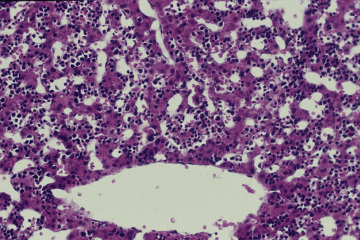 肝臓 29. 胎児の肝臓 1.
肝臓 29. 胎児の肝臓 1.
ヒト、6ヶ月の胎児の肝臓、パラフォルムアルデハイド・
グルタルアルデハイド固定液で還流固定、パラフィン包埋、
H-E染色、x 64.
胎児の肝臓は造血器官として非常に重要な機能を果たしている。------
肝細胞索と類洞の間の空間は、胎生7ヶ月頃までは、未分化な--------
間葉細胞で満たされており、これらの盛んな分裂によって、-----------
赤血球および各種の白血球が形成される。この図は胎生6ヶ月の------
ヒトの胎児の肝臓で、図の下部の大きな空間は中心静脈、これから----
放射状に肝細胞索と類洞とが配列している。還流固定されている------
ので類洞は空になっているが、類洞の外は造血細胞で満たされている。-
Liver 29. Embryonic liver 1.
Human embryo in the 6. month of gestation, perfusion fixation
with -
paraformaldehyde glutaraldehyde fixative, embedding with paraffin,
-
H-E stain, x 64.--------------------------------------------
The liver in embryo plays a very important roll in hemopoiesis.
------
In the early half of the embryonic period the space between hepatic
cell cords and sinusoids is filled with young mesenchymal cells.
------
They proliferate very actively and differentiate into blood cells,
-----
erythrocytes as well as leucocytes, and then enter into sinusoids.
---
In this figure there is a central vein at lower middle and hepatic
----
cell cords and sinusoids radiate therefrom. Because of perfusion
----
fixation sinusoids are empty but outside of them is, on the contrary,
-
filled with hemopoietic cells.-----------------------------------
戻る

